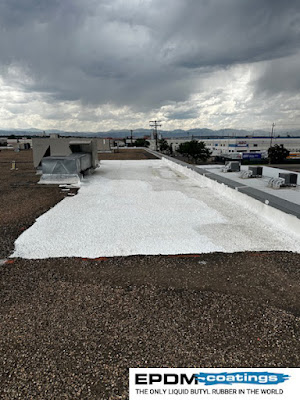Butyl rubber is a versatile material known for its excellent durability, flexibility, and resistance to harsh environmental conditions. It's widely used in various industries, but its application in roofing solutions is where it really shines. If you're looking to maintain or repair your roof, butyl rubber products can be your go-to solution.
In this article, we will explore what butyl rubber is, why it’s an excellent choice for roofing, and how it benefits various types of roofs, including liquid rubber roof, EPDM rubber roof, and more. We’ll also cover how it works as a liquid rubber roof sealant to help protect and extend the life of your roof.
What is Butyl Rubber?
Butyl rubber is a synthetic rubber, made by combining isobutylene and a small amount of isoprene. This unique combination results in a material that is highly resistant to water, chemicals, and extreme temperatures. One of its standout features is its air tightness, making it popular in applications like inner tubes, sealants, and especially roofing.
When applied to roofs, butyl rubber acts as a protective barrier, shielding the surface from water leaks, UV radiation, and temperature fluctuations. Its flexibility means it can stretch and adjust to various movements of the roof without cracking or tearing, making it highly effective for long-term use.
Why Choose Butyl Rubber for Your
Roof?
Here are some reasons why butyl rubber is an excellent choice for roofing:
Waterproofing: One of the primary reasons for using butyl rubber is its ability to create a watertight seal. It keeps your roof leak-free, even in heavy rainfall.
UV Resistance: Prolonged exposure to the sun can damage most roofing materials, but butyl rubber offers excellent resistance to UV radiation, which helps in maintaining the roof's condition over time.
Temperature Tolerance: Butyl rubber can withstand extreme temperature variations. Whether it’s freezing cold or scorching heat, this material remains stable and functional.
Durability: A properly applied butyl rubber roof can last decades without requiring major repairs. Its elasticity prevents cracking, making it an ideal solution for roofing in different climates.
Cost-Effective: Compared to other roofing materials, butyl rubber is a cost-effective option, especially considering its longevity and minimal maintenance requirements.
Liquid Rubber Roof and Butyl Rubber
If you're considering a roofing solution for your property, you may have come across liquid rubber roof. This liquid-applied roofing system offers seamless protection for various types of roofs, and butyl rubber plays a crucial role in making this possible. A liquid rubber roof can be applied over existing surfaces to create a continuous, leak-proof membrane, ideal for flat roofs, RVs, and other structures.
By incorporating butyl rubber into a liquid rubber roof, the material forms a flexible and durable layer that can move with the building's natural expansion and contraction without cracking or losing its waterproof properties. To explore more about how butyl rubber works in liquid roofing systems, you can visit EPDM Coatings.
EPDM Rubber Roof and Butyl Rubber
EPDM (Ethylene Propylene Diene Monomer) rubber is another highly popular roofing material that shares some similarities with butyl rubber. Both materials are synthetic, flexible, and weather-resistant. However, butyl rubber is particularly known for its superior water and gas resistance, which is why it’s often used in conjunction with an EPDM rubber roof for enhanced sealing around edges and penetrations.
When you combine the strength of EPDM rubber with the flexibility and sealing power of butyl rubber, you get a roofing solution that is extremely resistant to leaks, cracks, and wear. This pairing is especially beneficial for commercial and residential flat roofs, where water pooling can be a problem. For more information on how EPDM rubber roofing works with butyl sealants, check out EPDM Coatings.
Liquid Rubber Roof Sealant: Enhancing
Your Roof's Lifespan
Butyl rubber’s strength lies in its ability to act as a sealant. A liquid rubber roof sealant can be applied over a variety of surfaces, forming a protective layer that prevents water from penetrating the roof. The liquid form of butyl rubber is easy to apply, ensuring that even hard-to-reach areas are adequately covered.
This type of sealant is particularly useful in repairs. Whether you have small cracks, leaks, or joints that need sealing, a butyl-based liquid rubber roof sealant ensures that your roof remains watertight. For products and solutions that utilize this technology, visit EPDM Coatings.
Application of Butyl Rubber for Roof
Repair
Applying butyl rubber for roof repair or maintenance is straightforward. Here’s how the process typically works:
Cleaning the Surface: Ensure the roof is clean and free from debris. This helps the butyl rubber adhere better to the surface.
Applying the Butyl Rubber: Depending on the form, you can apply butyl rubber as a liquid, tape, or sheet. If you’re using a liquid rubber roof sealant, you can pour it directly onto the surface and spread it evenly with a roller or brush.
Allowing Time to Cure: Once applied, the material needs time to cure and form a strong, flexible layer. This can take anywhere from a few hours to a day, depending on the product and environmental conditions.
Inspecting the Roof: After the butyl rubber has cured, inspect the roof for any missed spots or areas that might need an additional layer of sealant.
Conclusion
Butyl rubber is a robust, cost-effective, and versatile solution for anyone looking to maintain or repair their roof. Whether you're using it as a liquid rubber roof, pairing it with an EPDM rubber roof, or applying it as a liquid rubber roof sealant, butyl rubber provides long-lasting protection and peace of mind. For more information on butyl rubber and how it can enhance your roofing system, visit EPDM Coatings.








No comments:
Post a Comment